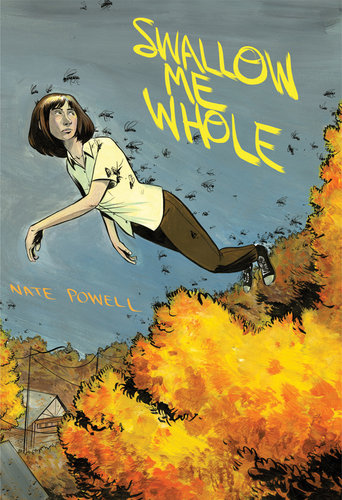Wolverine: Enemy of the State vol.1
A CAVEAT: First, let me say that, despite being a big comic fan, I am not an X-Men fan. I have tried on a number of occasions to get into the X-Universe, but I only ever last a few issues and then move on. Which is not to say that I don’t appreciate the characters or the themes inherent with Cyclops, Storm, Rogue, Wolverine, et al. I enjoyed the cartoon back in the early ninetie;, I loved Barry Windsor-Smith’s “Weapon X” storyline; and I thoroughly enjoyed the graphic novel, “God Loves, Man Kills” by Chris Claremont and Brent Anderson, which I see as the final word on mutants. So, we’ll see if Mark Millar can make me a believer.

Mark Millar is probably the most successful contemporary writer in comics, if one judges that by how well he’s managed to get his projects into the mainstream (read: Hollywood). With Wanted and Kick-Ass and other movie projects said to be in production, is there any other comic writer whose work has reached a wider audience (Stan Lee & Alan Moore excepted)?
To my knowledge, I’ve never read a full Mark Millar penned story. I began Wanted at my local Borders, but I couldn’t get through the second chapter. I got ten pages into the Ultimates and was too bored to continue. I did read Kick-Ass, but I missed out on some of the middle issues because of the publishing delays. Other than that, I’ve not read anything from Millar, though I am aware of him and of his penchant for pushing the envelope until it shreds to confetti. So I thought I should rectify this and investigate his work starting with the much-lauded twelve issue arc of Wolverine he did with JRJr, “Enemy of the State.”

Regarding the first volume – collecting issues 20-25 – I have to say, I was unimpressed. Millar’s work seems to consist of a nice, shiny patina of excessive violence lacking any heart. There was no emotional core, nothing upon which I could focus my attention in order to become engaged with the story.
Wolverine goes to Japan to help his dead fiancée’s cousin, whose son has been kidnapped (thankfully, Millar only uses Akira Kurosawa’s plot from High & Low, which was itself a loose adaptation of Ed McBain’s novel, King’s Ransom, as setup). Wolverine confronts the Hand ninjas and is taken down by a mutant who is apparently better than Wolverine at what Wolverine does best (killing). Then we get five issues of Wolverine killing recklessly, as he takes out heroes that the Hand will resurrect as part of the final-ditch effort Baron von Strucker is using to appease his wife and hold onto all that he’s amassed. So there are battles with the Fantastic Four (I’d love to see JRJr do a long run on this title), with Daredevil, with Elektra, with the X-Men, while Nick Fury and S.H.I.E.L.D. continue one step behind. And then, at the culmination of this first collection, they manage to capture Wolverine, with Nick Fury smirking, “We got our little killing machine back.”

If it weren’t for Romita, Jr’s artwork, I don’t know if I could have gotten through these first six issues. It was a chore. I found the fights boring – despite the art of JRJr – the decompression of the storytelling grating, and the absurd enhancements made to Wolverine by Hydra – who, along with a group of mutants known as the “Dawn of the White Light” – so outlandish, even for a comic, that I was pulled right out of the story.
Wolverine has enhancements that allow him to crack any code and lock? Seriously? #$%@ off, Mark Millar!
I also could not stand the fact that all the killing Wolverine does – under brainwashing by Hydra – was just dismissed by everyone, including Nick Fury. Oh, Wolverine’s brainwashed, so it doesn’t really matter. Come on! I realize these are comic books, but it used to be that the stories would revolve around actions having consequences (and no, I’m not advocating for the After School Special model of writing). Heroes forced to make difficult choices, and living with those choices, makes for interesting reading. Characters allowed to just kill pell-mell like this and have everybody just give him the benefit of the doubt – he isn’t doing this; it’s the brainwashing – just broke any sense of disbelief I had.

This is part of the problem with comics today. Death and killing are so commonplace that it has been rendered meaningless. How can you have an emotional moment when you know it doesn’t matter? Yes, I know Wolverine is all about killing, but it used to be he only killed the bad guys – and even that has worn thin for me; when something becomes commonplace it completely loses any impact it might have once had – but having him running through innocents and heroes with nobody caring – I’ll say it again: #$%@ off, Mark Millar!
Exiting the “condemnation train,” I have to say that the manner in which Rachel managed to outthink Wolverine after he’d infiltrated the X-mansion was a twist I did not see coming and extremely well done. Millar & JRJr set it up beautifully, showing Rachel fearful of Wolverine as he had her sync up to Cerebra and search for the President. Once linked in, Wolverine, along with us readers, could not tell who she was searching for; we could only base our assumptions on how she had allowed herself to be put into this position, apparently as a result of her fear of the situation. So, when she dismantles the terraforming device Wolverine brought with him to use as a threat, and she explains that she tapped into Reed Richards’s brain to figure out how to do it, I was impressed. If only there had been more than just this one great moment in the book.

Two final things.
First: in the initial chapter, we have two characters – TWO – respond to Wolverine’s thoughts. His thoughts. Now, it comes to light later in the collection that possibly the first one to respond to his thoughts – the Gorgon – may have some form of telepathy. I will concede that one. But the second character who responded to a direct statement from Wolverine’s thoughts was a nurse. How did that get through editorial, let alone make its way onto Millar’s desktop screen? That’s just sloppy.
Second: Captain America, when he takes out Wolverine in the final chapter of this first collection, makes a wise-ass remark as he slams Wolverine’s head with his S.H.I.E.L.D. – “Heal this.” Come on. These characters are supposed to be unique, but none of them had anything resembling a distinct voice. Having Cap utter such a brainless quip felt completely out of character. Steve Rogers is an army man, who has served his country and believes in the ideal of America. He has class, and that remark lacks anything resembling class. Millar thought he was being cute, and he just exhibited his tin ear.

And third (yeah, I said “two final things,” but I reserve the right to change the rules, this is my house): Why is S.H.I.E.L.D. having all the superheroes quarantine themselves while Wolverine is on the loose? S.H.I.E.L.D. agents are going to do a better job against Wolverine than the Fantastic Four, Dr. Strange, Daredevil, Captain America, the Falcon, etc. etc. etc. could as a collective group? Or singly? Whaaaatttt????!!!! That’s stupid.
Ugh. I wonder if I can stomach the second collection. I’m already feeling a bit queasy from the Greg Land cover to the volume. At least I know JRJr did the interiors. Maybe that will help me get through the rest of this piece of dreck.
We’ll see.
-chris





















































